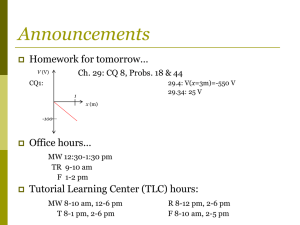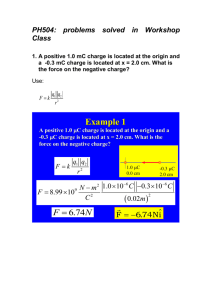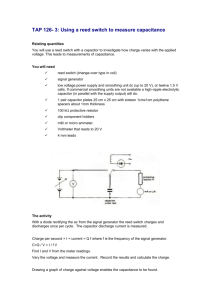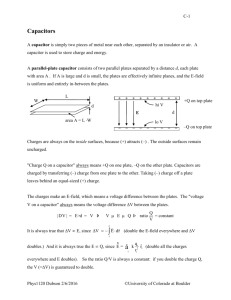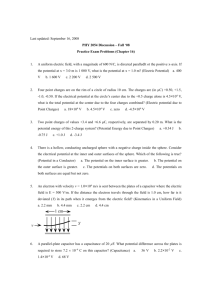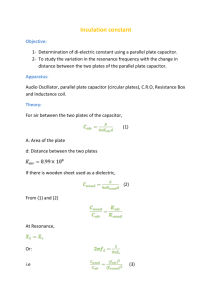CapacitorCTa
advertisement
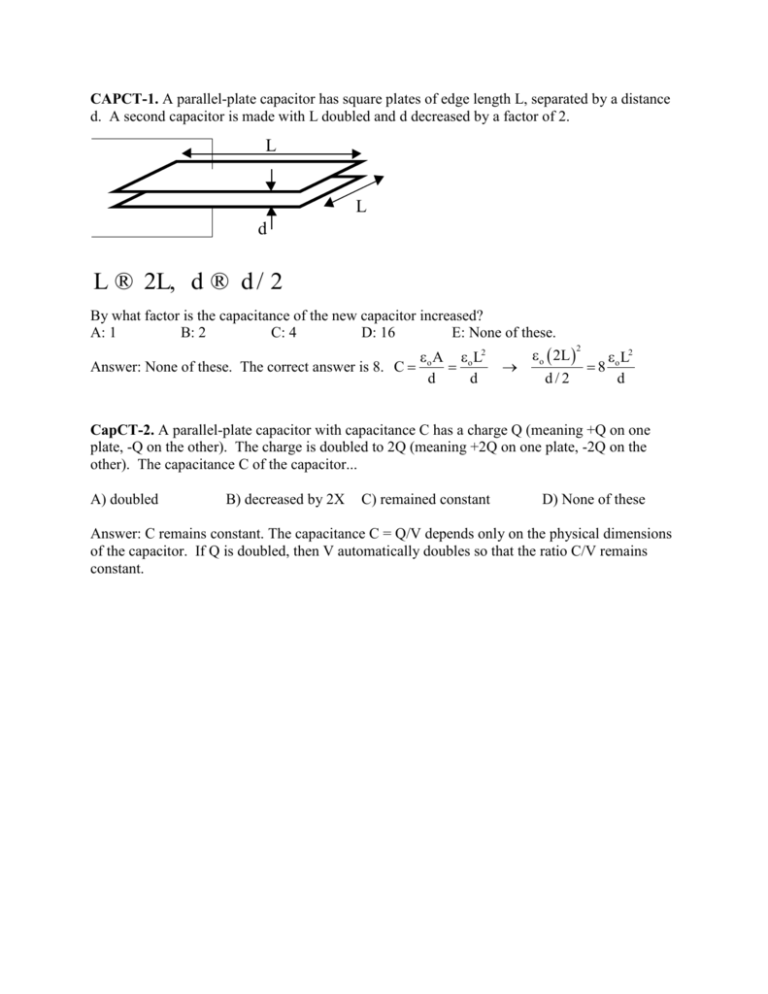
CAPCT-1. A parallel-plate capacitor has square plates of edge length L, separated by a distance d. A second capacitor is made with L doubled and d decreased by a factor of 2. L L d L ® 2L, d ® d / 2 By what factor is the capacitance of the new capacitor increased? A: 1 B: 2 C: 4 D: 16 E: None of these. o A o L2 Answer: None of these. The correct answer is 8. C d d o 2L d/2 2 o L2 8 d CapCT-2. A parallel-plate capacitor with capacitance C has a charge Q (meaning +Q on one plate, -Q on the other). The charge is doubled to 2Q (meaning +2Q on one plate, -2Q on the other). The capacitance C of the capacitor... A) doubled B) decreased by 2X C) remained constant D) None of these Answer: C remains constant. The capacitance C = Q/V depends only on the physical dimensions of the capacitor. If Q is doubled, then V automatically doubles so that the ratio C/V remains constant. CAPCT-3. A parallel-plate capacitor is charged up (+Q on one plate, -Q on the other). The plates are isolated so the charge Q cannot change. The plates are then pulled apart so that the plate separation d increases. The total electrostatic energy stored in the capacitor A: increases B: decreases +++++++++++++ + ------------------- C: remains constant. Answer: The energy increased, which we can see in three different ways: Method I. The Q is fixed and the C decreases (since C = 0A/d), so U = (1/2)Q2/C increases. Method II. The total energy stored in the field between the plates is (energy density) x volume = 1 o E 2 Volume . The field E = /o does not change (since the charge and charge density 2 does not change) but the volume between the plates increased, so the energy in the field increased. b g Method III. The external agent pulling the plates apart did positive work (since the plates attract). That positive work done was stored as increased electrostatic potential energy in the capacitor. The stored energy increased. CAPCT-4. A parallel plate capacitor is attached to a battery which maintains a constant voltage difference V between the capacitor plates. While the battery is attached, the plates are pulled apart so their separation increases. The electrostatic energy stored in the capacitor A: increases B: decreases V +++++++++++++ + C: stays constant. ------------------Answer: Using U = (1/2)CV2, we can see that the stored energy decreased. The Q on the plates was not constant (since the plates are not isolated) so we cannot use a formula involving the charge Q. The voltage V between the plates is held constant by the battery. (That's what a battery does - it maintains constant voltage difference between its terminals.) The capacitance C decreased as the plates were pulled apart (by C = 0A/d), so U = (1/2)CV2 decreased. Where did the energy go? Into the battery. What happened to the charge Q on the plates as the plates were pulled apart (at constant Voltage)? (Hint: What happened to the E-field? E-field is related to charge density.) Answer: The charge Q decreased. C = Q/V, since V was constant while C decreased, it must be that Q decreased. Alternatively, we can say that V = E d, so if d increases, E must decrease (since V is constant.). If E decreases, the charge density must decrease (since E = /o). If charge density decreases, the charge must decrease. CT25-5. A positive charge +Q and a negative charge –Q are held a distance R apart and are then released. The two particles accelerate toward each other as a result of their coulomb attraction. As the particles approach each other, the energy contained in the electric field surrounding the two charges.. A: increases B: decreases C: stays the same. + Answer: The energy in the E-field decreases. The energy density of the E-field is 12 o E 2 ; this is NOT the energy, it is the energy per volume. If the E-field is constant, the total energy is 2 2 1 1 2 o E volume . If the E-field is not constant, the total energy is 2 o E dV , where dV is a volume element. In this problem, the volume in which the E-field is large is roughly the space between the particles. This volume is decreasing rapidly as the particles approach each other. Although the E-field between the particles is increasing as they approach, the volume is decreasing more rapidly than the E-field is increasing, so the total energy is decreasing. Actually, I am glossing over some details: the exact calculation is pretty tricky, due to the divergence of the E-field near the point charges. Another way to see this is : When the two particles are infinitesimally close, so that they "on top of each other", the (+) charge cancels the (-) charge, and the E-field is zero. Then there is no energy in the field, so the field energy must have been decreasing as they approached. Where did the field energy go? It goes into the increased KE of the particles as they accelerated toward each other, and it goes into light that is emitted. CAPCT-6. A pair of isolated capacitor plates have charge Q. As the plates are slowly pulled apart, the magnitude of the E-field between the plates A) increases B) decreases C) remains constant As the plates are slowly pulled apart, the total electrostatic potential energy U and the energy density (energy per volume) u does what? + + + + + + + + + + _ _ _ _ _ _ _ _ _ A) U decreases and u increases B) U increases and u decreases C) U remains constant and u decreases D) U increases and u remains constant E) None of these Answers: As the plates are pulled apart, the E-field remains constant. The charge Q remains constant, so does charge/area = , and so does E-field, since E = /o As the plates are pulled apart, the total energy U increases and the energy density (energy per volume) remains constant. The energy density = u = 21 eo E 2 stays constant, since E stays constant. The total energy = density x volume increases since volume increases. CAPCT-7. The E-field surrounding a small metal sphere of radius R with total charge Q has magnitude E(r) = kQ r2 . Consider two concentric imaginary spherical shells, each with very small thickness dr, surrounding the charge. Recall that the volume of a shell with radius r is dV = 4p r 2dr . Which shell contains more field energy? A) the inner shell B) the outer shell C) both contain the same energy. Answer: the energy in a shell is dU = (energy per volume) x (volume of shell)= 2 æ1 ÷ ö 2 1 2 2 1 ç dU = u dV = 2 eo E (4p r )dr µ ç 2 ÷ r dr = 2 dr èr ø r As radius r increases, the energy in a shell decreases. +Q CAPCT-8. Two capacitors C1 and C2 are hooked in series. The equivalent series capacitance of the two capacitors is … A: Always less than C1 or C2 B: Always greater than C1+C2 C: Always greater than C1 or C2 but always less than C1+C2 D: None of these. = C1 C2 Cseries Answer: Cseries is less than either C1 or C2 . 1 1 1 1 1 1 1 and Since , that means . C series C1 C 2 Cser C1 Cser C2 But that means Cser < C1 and means Cser < C2. When you place capacitors in series, you always get a smaller capacitance. What you gain is the maximum voltage that can be placed across the capacitors. Suppose you have two 100 F capacitors, each rated at 20V (meaning that if you ever put more than 20V across that capacitor, it will be destroyed). If you put these in series, you will have a single equivalent series capacitor with capacitance Cser = 50 F and which can take 40V maximum voltage across its terminals.

